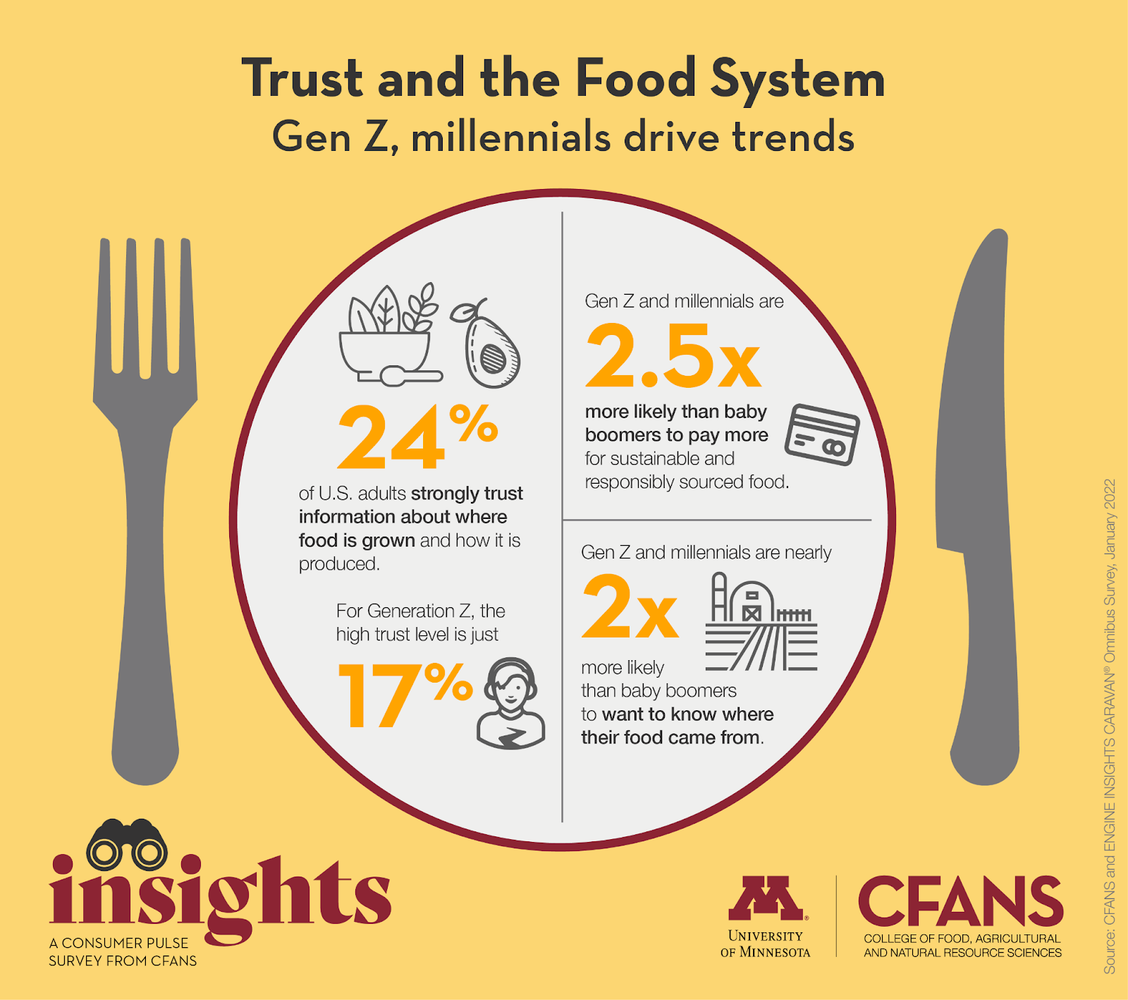
Bridging the food trust gap
CFANS Insights survey shows less than 25 percent of U.S. adults strongly trust information about where food is grown and how it is produced; trust gap even wider among Generation Z at 17 percent
Whether they’re stirring a pot at the stove or foraging in the fridge, the majority of U.S. adults are doing so without full trust in the information they get about their food.
Today’s consumers can’t turn on the TV or scroll social media without seeing ads from food companies espousing how consumers should feel good about eating their products. From ethically raised animals, to environmentally-conscious supply chains, to increased transparency about ingredients — consumers have more information at their disposal than ever before.
Yet there remains a disconnect between farm and fork. According to a new CFANS Insights survey from the University of Minnesota’s College of Food, Agricultural and Natural Resource Sciences (CFANS), only 24 percent of U.S. adults have a high degree of trust in the information they receive about where their food is grown and how it is produced. For Generation Z, the high trust level is just 17 percent. And with only 27 percent of survey respondents reporting a “very favorable” impression of agriculture and food production in the U.S., it is no surprise that farmers often feel misunderstood and under attack in the public eye.
“Today’s consumers are bombarded daily from all directions with messages about what they should or shouldn’t eat and why they should embrace one food but eschew another,” said Frances Homans, PhD, professor and head of the Department of Applied Economics and Department of Agricultural Education, Communication and Marketing (AECM). “But despite this deluge of data, we still see a disconnect in their understanding of what actually happens between farm and fork.”

Narrowing the gap
Garrett Steede, PhD, an assistant professor and major coordinator for Agricultural Communication and Marketing, is working closely with his colleagues to address this disconnect by preparing students to be successful leaders, educators, and communicators in agriculture, food, and natural resources (AFNR) careers.
“It’s encouraging that despite a gap among adults in trust about where food comes from, there is clearly an increasing interest among young people — from middle schoolers to undergraduate students in our majors — in studying AFNR and understanding the food system,” said Steede.
According to the National Association of Agricultural Educators, there are more than 13,000 middle, high school and post-secondary agriculture teachers nationwide — and demand is growing, including in urban areas. Every year, more than 100 new agriculture programs open and need highly qualified, diverse, and dedicated teachers. In Minnesota, school districts have added 21 AFNR programs since 2010, and 83 additional teaching positions had to be filled across the state. This is a 38 percent increase in teaching positions over ten years, with no signs of demand slowing. To accommodate this heightened interest, many Minnesota school districts are developing new AFNR programs — and they need more agriculture teachers to fill these critical positions.
Younger consumers willing to pay more for sustainable and responsibly sourced food
The CFANS Insights survey also showed that Gen Z and millennials (38 percent very willing) are two and a half times more likely than baby boomers (15 percent very willing) to pay more for sustainable and responsibly sourced food that ultimately benefits the environment.
“The awareness of the sustainability and environmental impact of our foods is increasing, particularly amongst our students,” said Job Ubbink, PhD, professor and head of the Department of Food Science and Nutrition. “People are increasingly signaling that they want to eat things that are not only good for them as an individual, but that contribute to a sustainable food system and equitable society. Costs, however, are often a hurdle, especially these days with mounting inflation."
Food science is essential in enabling this transformation of the food system to be more sustainable, whether that is developing plant proteins, making advances in traditional protein, or developing new novel crops, such as pennycress or Kernza.
Food origins important to next generation
Increasingly, consumers expect their food to be culturally relevant and come with a story of the journey it took to reach their dinner plates. Younger generations are more interested in knowing precisely where their food came from — for example, the specific farm a turkey was raised on, where grain was grown or cows were milked. Gen Z and millennials were nearly twice as likely to want to know where their food came from than baby boomers (almost 25 percent of Gen Z and millennials said it was extremely important, compared to 13 percent of baby boomers).
“It’s clear that our next generation of consumers is invested in our food system and in our environment,” said Homans. “They’re passionate about these topics, and we believe there’s an urgent need to create understanding about our food systems and supply chain while at the same time investing in science-based solutions and dynamic partnerships to feed a growing population and sustain our planet.
About the CFANS Insights Survey
The CFANS Insights survey is a regular consumer poll that explores key perceptions and opinions about important topics in food, agriculture, and natural resources. This survey was conducted in January 2022 by ENGINE INSIGHTS, polling a demographically representative sample of 1,022 adults in the United States.





